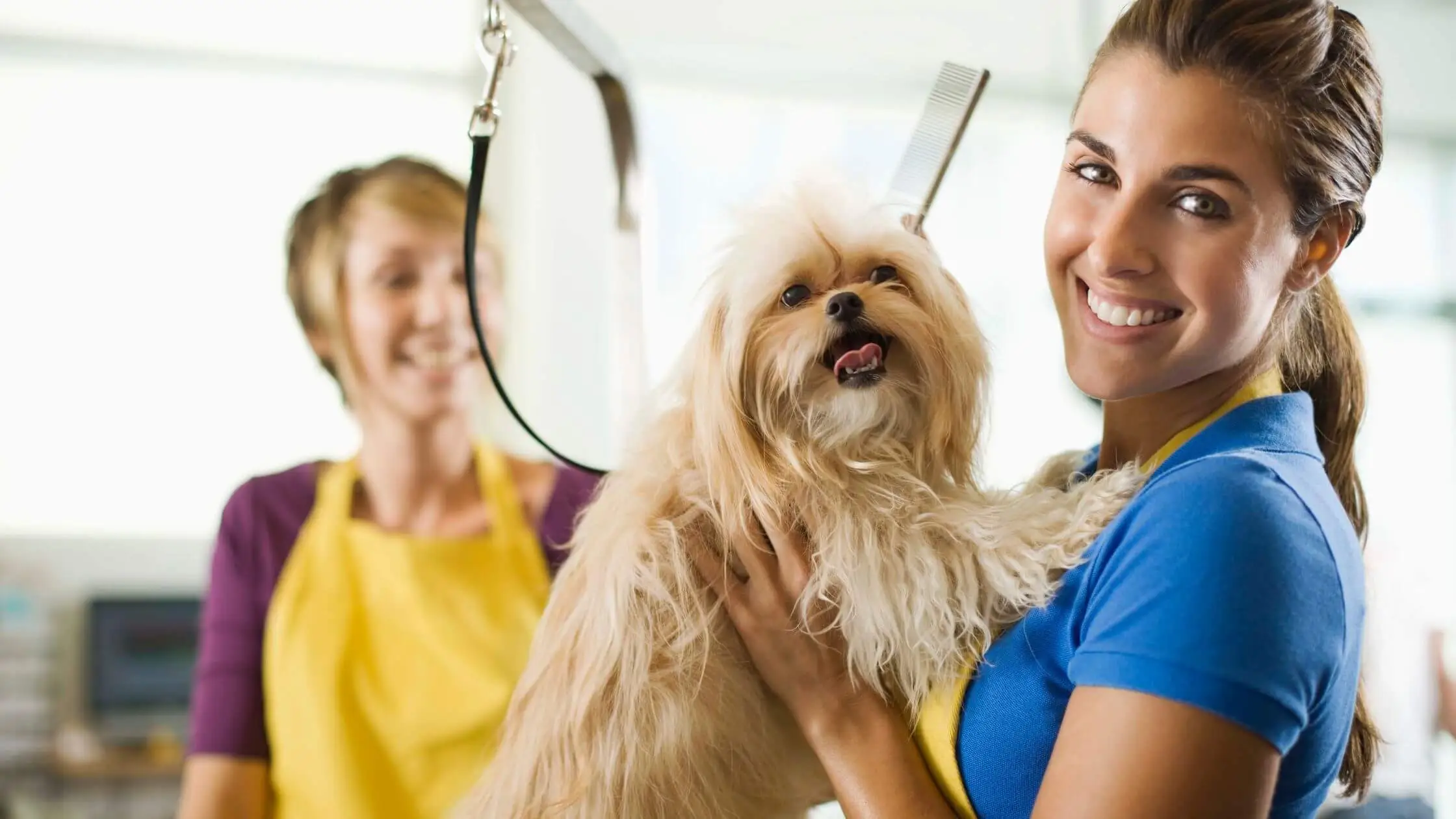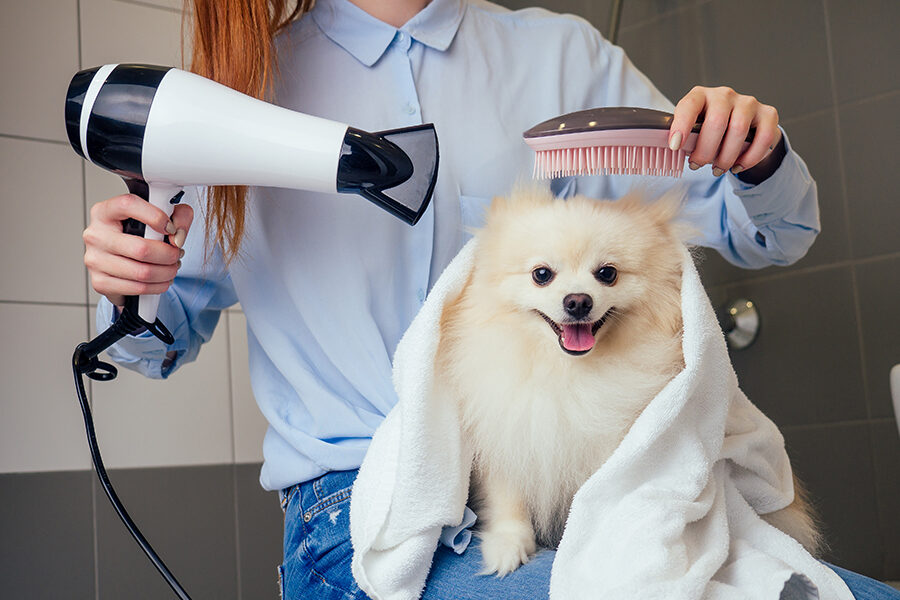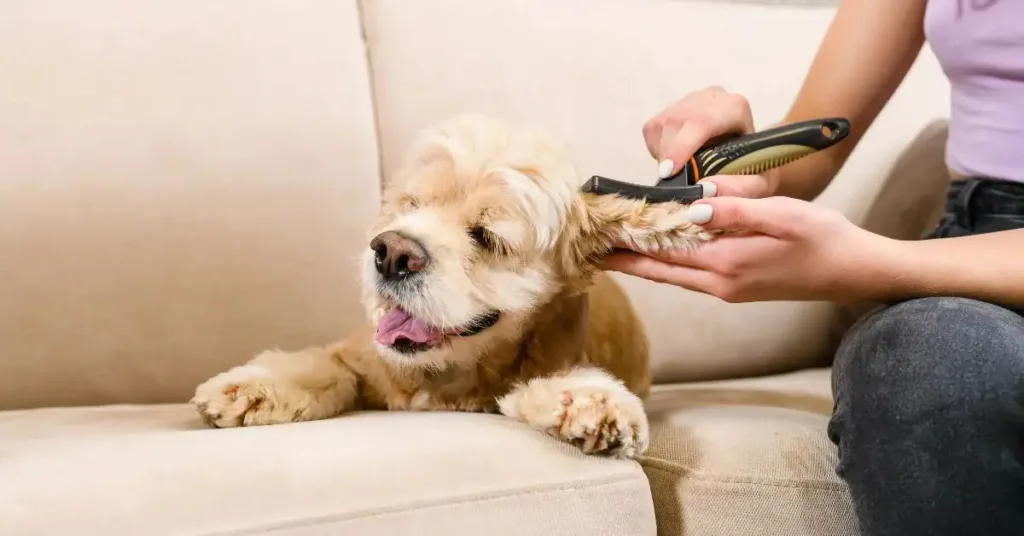New
Grooming at Home vs Professional Care: What’s Best for Your Pet?
Why Grooming Is More Than Just Beauty
For many guardians, brushing fur or clipping nails may seem like cosmetic work. In reality, grooming is central to overall wellness. A clean coat prevents matting, tangled knots, and skin infections. Regular brushing improves circulation, distributes natural oils, and strengthens the bond between animal and human. Nail care is equally important—overgrown claws may alter gait, leading to joint discomfort or posture issues.

Core Components of Grooming Routines
Pet hygiene routines typically include brushing, bathing, nail trimming, ear cleaning, and sometimes dental maintenance. Each species has distinct requirements. Dogs with double coats, such as Huskies, shed seasonally, demanding intensive combing. Short-haired cats shed year-round and benefit from frequent deshedding sessions. Bathing frequency also varies—some dogs tolerate water every few weeks, while cats often need baths only in exceptional cases.
Recognizing Grooming as Preventive Healthcare
Early detection of lumps, parasites, or skin irritation often happens during grooming sessions. A simple brushing moment can reveal ticks, fleas, or abnormal bumps. Professional groomers and attentive guardians alike act as the first line of defense, spotting changes before they escalate into serious conditions. Thus, grooming should be understood not only as beautification but also as preventive healthcare that improves lifespan and comfort.
Advantages and Challenges of Home Grooming
Benefits of Grooming at Home
Caring for pets at home allows flexibility and emotional closeness. Guardians can choose times that suit their schedule and adjust routines to match each animal’s comfort level. Pets often feel more relaxed in familiar environments, avoiding the stress of traveling or interacting with strangers. Home care also strengthens trust—animals learn to associate human touch with safety and attention.
Cost-Effectiveness and Convenience
Professional services, while valuable, can be expensive when repeated regularly. Home routines reduce long-term costs, especially for multi-pet households. Guardians who learn basic skills—such as brushing, nail clipping, or ear cleaning—save money while still maintaining a high level of care. In addition, performing grooming at home eliminates the need for appointments, waiting times, or transportation.
Challenges and Limitations of DIY Grooming
Despite its advantages, home care requires patience, knowledge, and proper tools. Some guardians may struggle with resistant pets who dislike brushing or claw trimming. Accidents such as cutting a nail too short can cause pain or bleeding. Bathing at home may also be difficult without the right setup, leading to incomplete rinsing or water spills. In complex situations—such as mat removal from long-haired breeds—lack of expertise can inadvertently harm the pet.
Balancing Training and Comfort
Teaching pets to accept grooming is a gradual process. Positive reinforcement, treats, and short sessions build tolerance. However, certain individuals may remain anxious no matter the approach. Guardians must recognize their own limits: if stress levels for either human or animal rise too high, professional intervention may be the safer and more effective option.
The Value of Professional Grooming Services
Expertise and Specialized Equipment
Professional groomers receive training that goes beyond basic brushing or bathing. They understand breed-specific coat types, skin sensitivities, and handling techniques for nervous pets. Their facilities often include specialized tools such as high-velocity dryers, grooming tables with safety restraints, and clippers designed for precision. This expertise ensures thorough results and minimizes risks.
Comprehensive Services Beyond Home Care
Professional grooming often includes extras that are difficult to replicate at home. Anal gland expression, sanitary trims, paw pad shaving, and breed-standard haircuts are just a few services typically offered. Many groomers also provide medicated baths for pets with allergies or skin conditions, ensuring that treatment is both effective and safe.

Socialization and Enrichment Opportunities
For some animals, visiting a grooming salon provides social stimulation. Interactions with groomers and exposure to new environments enhance adaptability. Dogs, in particular, may benefit from the structured routine of professional appointments, building resilience and reducing anxiety in unfamiliar settings.
Costs, Frequency, and Decision-Making
The primary drawback of professional grooming is financial commitment. Prices vary based on breed, coat condition, and location. Small short-haired dogs may require modest fees, while large long-haired breeds can cost significantly more. Guardians must weigh expenses against convenience, expertise, and time saved. Many households adopt a hybrid model—handling simple tasks at home while scheduling periodic professional sessions for more complex needs.
Choosing the Right Approach for Your Pet
There is no universal answer to whether home grooming or professional services are better. The ideal solution depends on species, breed, temperament, guardian skills, and lifestyle. Some pets thrive with weekly brushing and occasional baths at home, while others require the precision and expertise of a salon. A thoughtful balance—combining the emotional closeness of home routines with the thoroughness of professional care—often delivers the best outcome.
Reducing Stress Through Gentle Handling
Beyond physical benefits, grooming significantly impacts animal psychology. Calm, slow movements during brushing release tension, helping pets feel secure. Dogs often close their eyes or sigh during a session, while cats may knead their paws in contentment. These responses show grooming can be therapeutic, not just hygienic.
Trust Building Between Guardian and Companion
Every time a guardian trims a claw or cleans ears with care, the animal learns patience and develops trust. These small acts teach pets that human hands bring relief rather than discomfort. Repetition creates a lifelong sense of safety, particularly important for rescues or adopted animals with histories of neglect.
Managing Anxiety Through Professional Guidance
Some animals experience high anxiety during grooming attempts at home. Professionals trained in behavioral techniques often use soothing tones, calming pheromone sprays, or structured breaks. Their knowledge transforms potentially stressful events into manageable routines, ensuring the pet’s emotional stability while achieving cleanliness.
Innovations, Tools, and Evolving Practices
Technological Advancements in Pet Grooming
Modern grooming benefits from tools unimaginable decades ago. Cordless clippers reduce noise, high-velocity dryers shorten drying time, and ergonomic brushes prevent strain on both human and animal. Smart devices even track grooming schedules, reminding guardians when it is time for baths or trims.
At-Home Gadgets That Simplify Care
Robotic nail grinders, automatic de-shedding tools, and self-cleaning brushes empower guardians with little experience. Portable grooming tubs with built-in sprayers allow easier bathing at home without messy spills. These gadgets close the gap between home care and professional standards, making it feasible for more people to maintain healthy routines.
Specialized Products for Unique Needs
From hypoallergenic shampoos for sensitive skin to medicated foams addressing fungal issues, product variety has expanded widely. Coat-specific conditioners help curly-haired breeds maintain texture, while waterless sprays assist guardians who live in apartments without easy bathing facilities. Access to such specialized solutions ensures that home grooming is safer and more effective.
Professional Salons Embracing Innovation
Grooming salons also adopt advanced technologies, from ozone therapy baths to specialized drying cabins that maintain optimal temperature. Some establishments even offer spa-like treatments, integrating aromatherapy, massage, and moisturizing wraps. These innovations redefine grooming as a holistic experience rather than a mere necessity.
Cultural, Social, and Lifestyle Considerations
Regional and Cultural Perspectives on Grooming
Grooming traditions differ globally. In some Asian countries, stylish trims are popular, reflecting cultural aesthetics. In Western regions, emphasis often falls on practicality and hygiene. Recognizing these cultural values helps explain why certain breeds are clipped in specific ways or why spa-like treatments gain traction in urban areas.
The Role of Lifestyle in Grooming Choices
Busy professionals may rely more heavily on professional services, while retirees with more time often enjoy grooming as a daily ritual. Families with children sometimes turn grooming into bonding sessions, teaching responsibility through simple tasks like brushing. Each household adapts practices to match routines, priorities, and financial capacity.
Community and Social Aspects
Dog parks, grooming competitions, and breed shows illustrate how hygiene connects with social identity. Professionally groomed dogs often participate in exhibitions, while at-home cared-for animals reflect a guardian’s hands-on devotion. Grooming thus becomes both personal and social, shaping how pets are perceived in communities.
Hybrid Approaches for Balanced Solutions
Many guardians discover that a blended model works best. Routine brushing, paw cleaning, and minor trimming are performed at home, while professional salons handle complex tasks like styling, deshedding, or coat stripping. This approach maximizes emotional closeness while ensuring professional precision where necessary.
Final Thoughts: Expanding the Definition of Grooming
When comparing home care with professional services, it becomes clear that grooming transcends hygiene. It reflects love, commitment, and cultural values. Modern technology, lifestyle shifts, and psychological understanding all contribute to how grooming is practiced today.
The ultimate choice is not binary but fluid. Guardians may adjust approaches as pets age, as health conditions arise, or as life circumstances evolve. A puppy may benefit from frequent salon visits to learn socialization, while an older cat might thrive with gentle home routines free of travel stress.
What matters most is attentiveness—recognizing that grooming is not only about appearance but about dignity, comfort, and well-being. Whether through the quiet intimacy of a living room brushing or the expertise of a professional salon, every act of care adds to a pet’s quality of life and strengthens the unique bond shared with humans.
Skin as the First Line of Defense
The skin of dogs and cats acts as a protective barrier, shielding against pathogens, allergens, and environmental irritants. Proper grooming keeps this barrier intact by removing debris, controlling excess oils, and allowing pores to breathe. Without routine maintenance, clogged follicles can lead to infections or hot spots, causing discomfort and medical complications.
Coat Structure and Function
Different breeds display diverse coat structures: double coats, curly textures, wiry strands, or fine hair. Each type requires unique approaches to prevent damage. Double-coated breeds like Malamutes need undercoat raking to avoid matting, while curly-haired Poodles demand frequent trimming to prevent tangles. Ignoring coat-specific needs not only harms aesthetics but also compromises thermoregulation and comfort.
Physiological Benefits of Grooming
Brushing stimulates sebaceous glands, distributing natural oils evenly across the skin. This creates a glossy, protective layer that deters parasites and reduces irritation. Grooming also enhances blood flow to superficial tissues, supporting cell regeneration and immune function. Thus, grooming contributes not only to appearance but also to physiological vitality.
Real-World Perspectives and Practical Considerations
Case Studies From Guardians
Owners often report dramatic changes when consistent grooming is introduced. A neglected rescue dog with matted fur may transform into a vibrant companion after months of regular brushing and bathing. Cats prone to hairballs show reduced vomiting when deshedding combs are used weekly. These real-world outcomes highlight how small, steady efforts translate into measurable health improvements.
Professional Groomer Testimonials
Seasoned groomers describe their work as equal parts artistry and healthcare. They recount discovering skin tumors, ear infections, or dental issues during routine sessions—problems guardians had overlooked. Their expertise allows for early intervention, proving the value of professional care as a preventive medical tool.
Guardian Challenges and Learning Curves
Not every pet parent masters grooming overnight. Many face difficulties handling nervous animals or mastering nail trimming techniques. Educational resources—videos, workshops, or mentorship—bridge these gaps, empowering guardians to gradually acquire skills. As confidence grows, so does the ability to decide when to handle tasks personally and when to defer to professionals.
Economic and Insurance Implications
Pet grooming represents a significant financial consideration. Regular salon visits accumulate costs, particularly for large or high-maintenance breeds. Some guardians offset expenses through pet insurance policies that cover hygiene-related medical treatments, though routine grooming is rarely included. Understanding long-term economic commitments helps families plan sustainably.
Grooming in a Broader Cultural and Philosophical Context
Global Grooming Traditions
In Japan, pet spas integrate hot spring baths and aromatherapy, treating grooming as wellness therapy. In Scandinavian regions, practicality dominates, with guardians focusing on functionality during cold, wet months. In North America, breed shows emphasize elaborate styling, linking grooming with competition and prestige. These diverse traditions reflect how culture shapes the meaning of cleanliness.
Grooming as Respect and Dignity
Beyond hygiene, grooming embodies a philosophy of respect. Ensuring that an animal is free of mats, odors, or painful claws communicates that their comfort matters. It transforms caregiving into an ethical act, recognizing pets as sentient beings deserving of dignity and care.
Social Impact of Well-Groomed Pets
Public perception often links grooming quality with responsible ownership. Clean, well-kept pets are more welcome in shared spaces, from parks to cafés. In this way, grooming influences not just health but also social inclusion, strengthening the role of animals in community life.
The Future of Grooming: Trends and Innovations
Emerging technologies include AI-powered grooming robots, ultrasonic cleaning devices for ears, and eco-friendly salon concepts. The future likely combines convenience with sustainability, allowing guardians to maintain high standards without excessive effort or environmental cost.
Final Reflections
The debate between home grooming and professional services transcends logistics. It touches science, psychology, culture, and economics. Guardians must weigh immediate convenience against long-term benefits, balancing personal involvement with expert input.
Ultimately, the question is not “Which is better?” but rather “What combination suits each unique animal and household?” By recognizing grooming as a multifaceted practice—blending science, compassion, and tradition—guardians can provide the highest standard of care. In doing so, they honor the bond between species, ensuring pets not only look good but also feel cherished and respected.
Ultimately, the goal is not perfection but consistency. Regular grooming keeps pets comfortable, prevents health issues, and deepens the human-animal bond. Whether done with a brush in the living room or through expert hands at a grooming studio, what matters most is ensuring that every animal feels cared for, respected, and loved.
Life Stages and Grooming Needs
Puppies and Kittens: Early Habits Shape Future Comfort
Introducing grooming at an early age is crucial. Puppies and kittens exposed to gentle brushing, soft handling, and calm nail checks are more likely to accept care throughout life. At-home sessions during youth build resilience, while occasional professional visits acclimate them to salon environments, reducing fear later.
Adult Pets: Balancing Efficiency and Routine
During adulthood, coats are at their thickest, nails grow steadily, and energy levels are high. Guardians often find home brushing manageable, but professional trims or specialized baths provide deeper results. Combining both ensures pets remain comfortable without overwhelming owners.
Senior Companions: Special Considerations
Older dogs and cats may develop arthritis, reduced mobility, or sensitive skin. Home routines can be adapted with softer brushes, warm towels, and shorter sessions to prevent fatigue. Professional groomers trained in geriatric care use supportive tables and gentle products, making salon visits safe even for fragile animals.
Health Conditions and Grooming Adaptations
Allergies and Sensitive Skin
Animals with allergies require hypoallergenic shampoos, unscented wipes, and non-irritating tools. Guardians who overlook these needs risk worsening symptoms. Professional salons often stock medicated products tailored for dermatological issues, offering relief that may be hard to replicate at home.
Injuries or Post-Surgery Care
Pets recovering from injuries or surgery demand adapted grooming. Guardians may need to focus only on light brushing while avoiding surgical areas. Professionals, with veterinary collaboration, can provide safe handling and targeted hygiene while respecting medical restrictions.
Parasite Prevention and Control
Ticks, fleas, and mites often reveal themselves during grooming. Home guardians may detect early signs, but professionals use magnification tools and targeted products for thorough eradication. Joint vigilance ensures parasites are controlled quickly, preventing infestations.
Environmental Factors Shaping Grooming Routines
Urban Living vs Rural Settings
City pets often encounter pollution, dust, and artificial surfaces, demanding frequent paw cleaning and coat care. Conversely, rural animals may face mud, burrs, or seeds caught in fur, requiring combing and detangling. Grooming strategies must adapt to environment-specific challenges.
Climate and Seasonal Influences
Hot, humid climates foster fungal growth and odor, making professional baths beneficial. Cold regions necessitate thicker coats, where undercoat management is critical to prevent overheating indoors. Seasonal transitions—spring shedding or winter matting—dictate grooming frequency and style.
Household Context
Multi-pet homes generate more dander and hair, motivating guardians to maintain stricter hygiene. Families with allergies may rely on professional deep-cleaning to keep environments manageable. Conversely, single-pet households may find DIY methods sufficient for control.
Time, Cost, and Emotional Value
Financial Breakdown of Grooming Choices
At-home care typically involves upfront investment in brushes, clippers, and shampoos. Professional services, though recurring, provide convenience and expertise. Over years, the cost difference widens, prompting guardians to calculate what fits their budget while prioritizing quality.
Time Commitment and Scheduling
Home grooming requires personal dedication. Busy individuals may neglect sessions, leading to matting or discomfort. Professional appointments ensure consistency, though travel and waiting add time burdens. Each guardian must decide whether money or personal time is the scarcer resource.
Emotional Rewards of Personal Involvement
While professional salons guarantee polish, at-home care strengthens bonds. Brushing a cat on the couch or massaging shampoo into a dog’s coat provides shared relaxation. These intangible rewards cannot be measured financially but contribute significantly to mutual trust.
Global Trends and Innovative Approaches
Mobile Grooming Services
A growing trend involves vans equipped with grooming stations visiting homes. This hybrid approach merges professional expertise with familiar surroundings, reducing stress for anxious pets while sparing guardians travel time.
Luxury and Spa Treatments
High-end markets now offer facials, pawdicures, aromatherapy, and even fur dyeing. While not necessary for health, these services reflect cultural shifts toward treating pets as family members deserving indulgence.
DIY Kits and Education Platforms
The rise of online tutorials and subscription grooming boxes empowers guardians to experiment with at-home methods. Kits often include tools, instructions, and product samples, bridging the gap between amateur care and professional results.
Grooming as Philosophy and Responsibility
Ethical Dimension of Care
Cleanliness is not only aesthetic—it conveys respect. A well-groomed animal is less likely to suffer preventable discomforts, demonstrating a guardian’s responsibility. Grooming thus becomes an ethical practice rooted in compassion.
Grooming as Language of Love
Every stroke of a brush or careful nail clip communicates affection. Pets may not understand words, but they feel attention and patience. These gestures express love as tangibly as play or treats.
Responsibility Beyond Appearance
A neglected coat, overgrown nails, or dirty ears are not just cosmetic flaws—they signal unmet needs. Recognizing grooming as essential, not optional, shifts mindsets from vanity to health and dignity.
Final Thoughts: The Ongoing Balance
The question of home versus professional grooming does not yield a single answer. Instead, it evolves with each pet’s stage of life, health conditions, and household realities. Guardians may start with DIY approaches, integrate occasional salon visits, and later rely more heavily on professionals as pets age.
What remains constant is the guiding principle: grooming is an act of love. Whether performed with clippers in a living room or scissors in a salon, the outcome is not only a clean animal but also a cared-for soul. The true measure of success lies not in style but in comfort, health, and the strengthened connection between human and companion.

